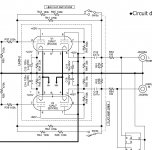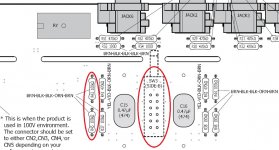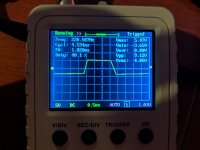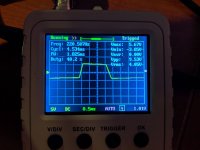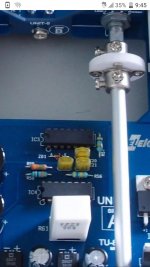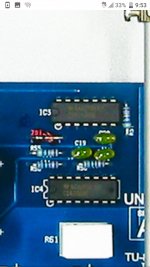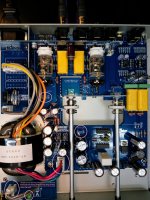My first real build.... I built a little tube preamp from Amazon to actually test my skills before investing in a nice kit.
Well. This is a great piece of work. The instructions are great. The level of prefab is awesome. It really is a big jigsaw puzzle with a set of directions on how to figure it out!
I was really happy with the placement of the components. I didn't find anything incredibly hard to solder. All the pads were of good size so that the iron could get in and make a good joint. I actually thought the hardest thing to solder would have been the two ICs but in actuality I only really was concerned with the 1/8" jack.
I was very happy to get the kit together in an evening. Well, I got about 2/3 done in one evening and then finished it over lunch the next day. I was excited to have it power up and work on the first try! All the inputs including the phono work fine!
I built this because my Musical Paradise MP-301 integrated amp doesn't have a phono input. Running my turntable through to this amp made some sweet sweet sounds fill the room. I also tried pulling audio from my JDS Labs Element DAC, through the 8500, and out to my Koss Electrostatic headphones. Also great success!
I have encountered one issue, however. The flat gain switch is giving me odd behavior. When changing to 1x gain it seems like only one channel, the right, is going to the lower gain while the left says at the same level. I double checked the solder joints on the switch and they all look good. I took the board out and checked through everything and just can't seem to find a bad connection. I'd really like to get some pointers on what to check. It seems odd that at high gain things are good but low gain a channel performs weird.
I'm not the best at easing a schematic but I guess I'll have to pull it out and start poking around with a meter. A bad or off tube wouldn't be the culprit, would it?
In all I'm really happy with this kit. I really like Elekit's approach and the whole thing is top notch. I guess I'm now leaning on building the 300B amp!
Well. This is a great piece of work. The instructions are great. The level of prefab is awesome. It really is a big jigsaw puzzle with a set of directions on how to figure it out!
I was really happy with the placement of the components. I didn't find anything incredibly hard to solder. All the pads were of good size so that the iron could get in and make a good joint. I actually thought the hardest thing to solder would have been the two ICs but in actuality I only really was concerned with the 1/8" jack.
I was very happy to get the kit together in an evening. Well, I got about 2/3 done in one evening and then finished it over lunch the next day. I was excited to have it power up and work on the first try! All the inputs including the phono work fine!
I built this because my Musical Paradise MP-301 integrated amp doesn't have a phono input. Running my turntable through to this amp made some sweet sweet sounds fill the room. I also tried pulling audio from my JDS Labs Element DAC, through the 8500, and out to my Koss Electrostatic headphones. Also great success!
I have encountered one issue, however. The flat gain switch is giving me odd behavior. When changing to 1x gain it seems like only one channel, the right, is going to the lower gain while the left says at the same level. I double checked the solder joints on the switch and they all look good. I took the board out and checked through everything and just can't seem to find a bad connection. I'd really like to get some pointers on what to check. It seems odd that at high gain things are good but low gain a channel performs weird.
I'm not the best at easing a schematic but I guess I'll have to pull it out and start poking around with a meter. A bad or off tube wouldn't be the culprit, would it?
In all I'm really happy with this kit. I really like Elekit's approach and the whole thing is top notch. I guess I'm now leaning on building the 300B amp!
The flat gain switch is giving me odd behavior. When changing to 1x gain it seems like
only one channel, the right, is going to the lower gain while the left says at the same level.
I'd use an ohm meter on the unpowered unit, to check the switch and related components.
I'd use an ohm meter on the unpowered unit, to check the switch and related components.
There are two of these push button switches. I tried to see what each of the poles did with my meter but wasn't able to see anything that made sense. Looking at the schematic it isn't clear how the poles control what on the board is switched on and off.
Ding ding ding! We have a winner!
Bad solder joint. I found one but re-flowed all on the output.
Thank you so much for helping me figure that one out!
Now something I'm noticing seems to be a balance issue on the phono side. I have a JDSLabs Element DAC hooked up on line 1 and an Technics SL-Q5 on phono. To me the left channel seems to have a little more gain. I've been switching between the DAC and my turntable playing Led Zepplin I. On the phono side the high hat in "I Can't Quit You Baby" Really seems to take over the left ear while the whole sound seems more in balance coming from the DAC. I want to suspect that it is the recording and the difference between a EAC rip I made and the remaster vinyl I just purchased from Amazon.
Is there a way to put a test tone from a known source through the phono inputs to test the output without a crazy set of gear? I had hoped to use some source through the phono to see if it is a perception or actuality? I thought about buying a a kit oscilloscope and tone generator. Would this be the only way?
Bad solder joint. I found one but re-flowed all on the output.
Thank you so much for helping me figure that one out!
Now something I'm noticing seems to be a balance issue on the phono side. I have a JDSLabs Element DAC hooked up on line 1 and an Technics SL-Q5 on phono. To me the left channel seems to have a little more gain. I've been switching between the DAC and my turntable playing Led Zepplin I. On the phono side the high hat in "I Can't Quit You Baby" Really seems to take over the left ear while the whole sound seems more in balance coming from the DAC. I want to suspect that it is the recording and the difference between a EAC rip I made and the remaster vinyl I just purchased from Amazon.
Is there a way to put a test tone from a known source through the phono inputs to test the output without a crazy set of gear? I had hoped to use some source through the phono to see if it is a perception or actuality? I thought about buying a a kit oscilloscope and tone generator. Would this be the only way?
Sorry for the double post (I couldn't find a way to edit the last one).
Even if I had a signal generator would I need something like a "reverse RIAA filter" as advertised by tubes4hifi? http://www.tubes4hifi.com/pre11.htm
Even if I had a signal generator would I need something like a "reverse RIAA filter" as advertised by tubes4hifi? http://www.tubes4hifi.com/pre11.htm
Is there a way to put a test tone from a known source through the phono inputs to test the output without a crazy set of gear? I had hoped to use some source through the phono to see if it is a perception or actuality?
First reverse the turntable leads to see if the problem switches sides, if so it's the tt.
With no inverse RIAA filter, you can still use a 1kHz sine for testing the phono stage. There are web sites with a free tone generator, which goes to your PC headphone jack. Use a 1V sine at 1kHz, attenuated by 1/1000 with a resistor divider, 100k/100R, fed to both phono inputs. The phono outputs should then be identical. A decent AC rated DVM should be adequate for comparative measuring of the outputs, or you can do a listening test for a centered mono signal.
Or, make an inverse RIAA circuit (easy to build one) with a single input, and feed the output to both phono input channels. Then both phono preamp outputs should be identical with any line level test signal (sine, FM, CD, etc.) with a DVM, or by listening.
Last edited:
Now something I'm noticing seems to be a balance issue on the phono side. I have a JDSLabs Element DAC hooked up on line 1 and an Technics SL-Q5 on phono. To me the left channel seems to have a little more gain. I've been switching between the DAC and my turntable playing Led Zepplin I. On the phono side the high hat in "I Can't Quit You Baby" Really seems to take over the left ear while the whole sound seems more in balance coming from the DAC. I want to suspect that it is the recording and the difference between a EAC rip I made and the remaster vinyl I just purchased from Amazon.
The Led Zeppelin I is a fantastic debut album and even though I had heard Zep III/IV/The Song Remains The Same earlier, it was still a revelation to me a few decades ago.
I compared 3 versions of this album using headphones. The first one is my 2nd generation LP from the 80's. The second one is a CD from the 90's. The 3rd one is the 2012 remix from Tidal.
This song has a kind of artificially exaggerated stereo image, which was very common in those days. The results are interesting.
1) LP: The hi-hat clearly sounds from the left and the bass guitar from the right
2) CD: The hi-hat clearly sounds from the right and the bass guitar from the left
3) Tidal: The hi-hat clearly sounds from the left and the bass guitar from the right, same as the LP
I used the same DAC for both digital sources so reversed RCA cables could not cause this difference. The CD was simply issued with reverse channels, all other tracks sound the same.
I also compared similar releases of the Physical Graffiti, and they are all in sync. On the other hand, it was very disappointing to hear how much worse the 2012 PG remix sounds than either the LP or the CD. The highs are coarse, and it lacks dynamics and bass impact overall.
The main reason, I suspect, is that the original master tapes have faded considerably for the last few decades and a lot of digital post-processing is required to bring them to an acceptable level. There is a very good change that you get the same digital files with the LP remasters.
First reverse the turntable leads to see if the problem switches sides, if so it's the tt.
With no inverse RIAA filter, you can still use a 1kHz sine for testing the phono stage. There are web sites with a free tone generator, which goes to your PC headphone jack. Use a 1V sine at 1kHz, attenuated by 1/1000 with a resistor divider, 100k/100R, fed to both phono inputs. The phono outputs should then be identical. A decent AC rated DVM should be adequate for comparative measuring of the outputs, or you can do a listening test for a centered mono signal.
Or, make an inverse RIAA circuit (easy to build one) with a single input, and feed the output to both phono input channels. Then both phono preamp outputs should be identical with any line level test signal (sine, FM, CD, etc.) with a DVM, or by listening.
I really noticed the issue during the test LP session. When I first started my testing I was just playing some older LPs that I received from my dad. During this I was just making sure everything was working, no odd hums or noise, and wasn't really "listening" to the music. I was listening for the stuff between the notes!
Which is why I am happy that paczeltf has replied:
The Led Zeppelin I is a fantastic debut album and even though I had heard Zep III/IV/The Song Remains The Same earlier, it was still a revelation to me a few decades ago.
I compared 3 versions of this album using headphones. The first one is my 2nd generation LP from the 80's. The second one is a CD from the 90's. The 3rd one is the 2012 remix from Tidal.
This song has a kind of artificially exaggerated stereo image, which was very common in those days. The results are interesting.
1) LP: The hi-hat clearly sounds from the left and the bass guitar from the right
2) CD: The hi-hat clearly sounds from the right and the bass guitar from the left
3) Tidal: The hi-hat clearly sounds from the left and the bass guitar from the right, same as the LP
I used the same DAC for both digital sources so reversed RCA cables could not cause this difference. The CD was simply issued with reverse channels, all other tracks sound the same.
I also compared similar releases of the Physical Graffiti, and they are all in sync. On the other hand, it was very disappointing to hear how much worse the 2012 PG remix sounds than either the LP or the CD. The highs are coarse, and it lacks dynamics and bass impact overall.
The main reason, I suspect, is that the original master tapes have faded considerably for the last few decades and a lot of digital post-processing is required to bring them to an acceptable level. There is a very good change that you get the same digital files with the LP remasters.
Thank you so much for your response! In a celebration of getting my preamp finished I bought three LPs from Amazon. Dark Side of the Moon, Led Zepplin I, and Yo-Yo Ma's Six Evolutions (Bach Cello Suites). I spun DSM over the loudspeakers just to enjoy the thrill of listening to something on vinyl.
I use "I Can't Quit You Baby" as an all around test for quality. The dynamic range, stereo separation, and range of frequencies make it really show how your gear is working. Have a hiss and you'll hear it in the breaks in the solo. You really gotta love JPJ's walking bass line and you need good bass reproduction to not muddy it up. The high hat and cymbals really let you know if your source is good as well. Low quality rip and it will be horrid to your ears. Also lets you know if you have odd clipping. Oh, and it doesn't hurt to hear both Page and Plant wail!
Yesterday I listened through the cello suites. I haven't gone through them critically yet. Just had them on while I was doing work. However, I noticed that as a solo performance it seems as if the balance is correct. I have some Koss electrostatic cans that I'm going to use when I really want to enjoy the album.
So I think I'm safe here. I think I will go and order that DIY oscilloscope and signal generator from Amazon. It will be fun just to solder them up and fiddle with them, but I don't think I have an issue with the preamp. I did forget to mention that when I went back and reflowed the solder on the amp circuit that I switched the stock tubes out to some Mullard reproductions. I only have about an hour on them but they already sound great.
Another huge thanks to Elekit for putting together this awesome kit! Now I just need to hide my CC so I don't go out and get that 300B kit!
I hooked up a signal generator and a oscilloscope to the preamp on one of the line inputs and the phone input. Attached is the left and right channel outputs. I don't recall which channel is which. I assume it's not a standard curve because of the RIAA equalization. Is there enough difference to warrant checking further?
Attachments
Check what you installed for R55 and R56.
If you go by the Japanese schematic you get R55=3.3M and R56=470k.
If you go by the English instructions, you get R55=470k and R56=10k. ��
I'm in the process of the build myself and still unsure which R55, R56 values are actually correct (although my guess is that the original Japanese schematic is more likely correct)
I zoomed in on completed build photos of the TU-8500 online and found that unfortunately half the people are building them with incorrect resistance for R55 and R56 and are not aware.
If you go by the Japanese schematic you get R55=3.3M and R56=470k.
If you go by the English instructions, you get R55=470k and R56=10k. ��
I'm in the process of the build myself and still unsure which R55, R56 values are actually correct (although my guess is that the original Japanese schematic is more likely correct)
I zoomed in on completed build photos of the TU-8500 online and found that unfortunately half the people are building them with incorrect resistance for R55 and R56 and are not aware.
Last edited:
Hello, I just finished the build and am getting no output and don't know why or what else to check to isolate the problem.
I have checked voltages at both test points. I got 136.2V at the 140V test point and 12V/12.12V at the two 12V test point(s). Tubes light up. LED stays off when turned on unless I push down hard on either the CN1 or CN7 connector, although both connectors are snapped perfectly in place and solder joints all look good underneath. Even when I get the LED to temporarily light up, there is still no output.
I was extremely careful, neat and tidy with my assembly and took my time while waiting for parts to arrive and complete the build. All resistors installed with mirrored, symmetrical color bands on both sides and larger caps lined up to the best of their ability. At initial startup, there was no pops or smoke or anything- just complete silence. All components still look good and correct, polarity has been properly observed (from what I can tell) but there is still no sound.
Pictured are ShuGuang Sounds of Nature 12AT7's. I also tried the Chinese 12AU7's to rule out the tubes- there is no sound output with either set of tubes. * I circled wrong test point on the photo for the 12V tests. Does anything look out of place or does anyone have any idea what may be wrong? Thank you.
I have checked voltages at both test points. I got 136.2V at the 140V test point and 12V/12.12V at the two 12V test point(s). Tubes light up. LED stays off when turned on unless I push down hard on either the CN1 or CN7 connector, although both connectors are snapped perfectly in place and solder joints all look good underneath. Even when I get the LED to temporarily light up, there is still no output.
I was extremely careful, neat and tidy with my assembly and took my time while waiting for parts to arrive and complete the build. All resistors installed with mirrored, symmetrical color bands on both sides and larger caps lined up to the best of their ability. At initial startup, there was no pops or smoke or anything- just complete silence. All components still look good and correct, polarity has been properly observed (from what I can tell) but there is still no sound.
Pictured are ShuGuang Sounds of Nature 12AT7's. I also tried the Chinese 12AU7's to rule out the tubes- there is no sound output with either set of tubes. * I circled wrong test point on the photo for the 12V tests. Does anything look out of place or does anyone have any idea what may be wrong? Thank you.
Attachments
Last edited:
Hey! I got it all worked out and it sounds terrific. Mea culpa. It was a loose shared ground binding post screw connection and two unsoldered relay joints I missed.
I changed a few selected pairs of resistors to precision wirewound vishay/dale, a few electrolytics to higher voltage elna silmic ii that tested out better than the originals for uf, ESR. I kept microfarad values stock. Gold plated heavier duty ceramic tube sockets, gold plated mill-max opamp sockets, vintage NOS Philips polycarbonates, polystyrenes and even a pair of ERO MKT1822 poly's in the phono section to replace a few of the red metalized capacitors and finally a new matched pair of ShuGuang 12AT7 'Sounds of Nature' tubes to replace the stock Chinese 12AU7's.
I changed a few selected pairs of resistors to precision wirewound vishay/dale, a few electrolytics to higher voltage elna silmic ii that tested out better than the originals for uf, ESR. I kept microfarad values stock. Gold plated heavier duty ceramic tube sockets, gold plated mill-max opamp sockets, vintage NOS Philips polycarbonates, polystyrenes and even a pair of ERO MKT1822 poly's in the phono section to replace a few of the red metalized capacitors and finally a new matched pair of ShuGuang 12AT7 'Sounds of Nature' tubes to replace the stock Chinese 12AU7's.
Last edited:
